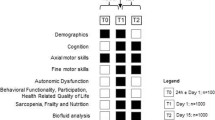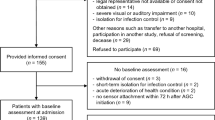Abstract
Background
Given the demographic changes, the need for effective geriatric intervention is obvious. Geriatric care aims to maintain the highest possible level of independence and quality of life and to reduce the risk of need for care.
Objectives
This study investigated the benefits of geriatric care on functional performance, mobility and cognition.
Material and methods
This study involved a retrospective analysis of clinical data from 646 patients. At hospital admission and discharge functional status was assessed using the Barthel index. Mobility was evaluated by means of the Tinetti test and cognition by the mini-mental state examination (MMSE). A follow-up was conducted on 112 patients 2–5 months after hospital discharge. Statistical analysis included t-tests including Cohen's d for effect size and multivariate regression analysis.
Results
The mean age of the study population was 81.1 ± 7.1 years including 439 women (68 %) and 207 men (32 %). There were significant average improvements for activities of daily living (ADL), mobility and cognition comparing discharge and admission scores. For functional and mobility status, effect sizes were medium to high. Regression analyses showed that ADL improvement was predicted by functional, mobile and cognitive status at admission. Follow-up analyses revealed a high percentage of former patients still living at home and an overall maintenance of ADL levels.
Conclusion
Geriatric patients seem to experience long-term improvements during geriatric treatment, which appears to fulfill its aim of recovering independence. For a better understanding of relevant factors for the recreation of geriatric patients, further research is needed, e.g. with respect to the impact of the nutritional status.
Zusammenfassung
Hintergrund
Durch den demographischen Wandel in Deutschland wird die Bedeutung effektiver geriatrischer Interventionen immer größer. Die geriatrische Versorgung zielt darauf ab, das höchstmögliche Niveau an Selbständigkeit und Lebensqualität zu erhalten und das Risiko für Pflegebedürftigkeit zu verringern.
Ziel der Arbeit
Die Studie untersuchte die Fortschritte hinsichtlich der ADL („activities of daily living“), der Mobilität und der Kognition während einer geriatrischen Behandlung.
Material und Methoden
Die Studie umfasste eine retrospektive Analyse klinischer Daten von 646 Patienten. Bei Aufnahme und Entlassung war der funktionelle Status mit dem Barthel-Index erhoben worden, für die Mobilität war der Tinetti-Test und für die Kognition die MMSE („mini-mental state examination“) verwendet worden. Zwei bis 5 Monate nach Entlassung erfolgte eine Nacherhebung mit 112 der ehemaligen Patienten. Die statistische Auswertung umfasste t-Tests mit Cohens d als Maß für die Effektstärke und eine multivariate Regressionsanalyse.
Ergebnisse
Das Durchschnittsalter des Studienkollektivs betrug 81,1 ± 7,1 Jahre (439 Frauen, 68 %; 207 Männer, 32 %). Beim Vergleich von Aufnahme- und Entlassungswerten konnten sowohl in den ADL als auch in Mobilität und Kognition im Mittel signifikante Verbesserungen festgestellt werden. Für ADL und Mobilität waren mittlere bis hohe Effektstärken nachweisbar. Regressionsanalytisch zeigte sich, dass die Fortschritte in den ADL durch den funktionellen, mobilen und kognitiven Status bei Aufnahme vorhergesagt wurden. Beim Follow-up lebte die Mehrheit der nach Hause entlassenen Patienten weiterhin in der eigenen Häuslichkeit bei unverändertem ADL-Niveau.
Diskussion
Geriatrische Patienten profitieren längerfristig von geriatrischer Behandlung, welche ihr Ziel, den Erhalt der Selbstständigkeit, erfüllt. Um Faktoren für die Erholung geriatrischer Patienten besser zu verstehen, ist weitere Forschung nötig, zum Beispiel hinsichtlich des Ernährungsstatus.



Similar content being viewed by others
References
Alvino S, Baeyens JP, Bone MP, Chirita D, Hirsch F, Husson JM, Hirsch F, Husson JM, Maman M, Piette F, Tinker A, Vetel JM, von Raison F (2013) EFGCP Guidelines on Medical Research for and with older people in Europe. https://www.google.de/url?sa=trct=jq=esrc=ssource=webcd=1ved=0CCMQFjAAurl=https%3A%2F%2Fwww.kcl.ac.uk%2Fsspp%2Fdepartments%2Fsshm%2Fnews%2FEFGCP-GMWP-Research-Guidelines-Final-edited-2013-05-27.pdfei=iUuxVKLaDIveOK7lgKAEusg=AFQjCNGRM8WbUe9oY8A4k6BFcnIbRVQg3g. Accessed 10 Jan 2015
Bachmann S, Finger C, Huss A, Egger M, Stuck AE, Clough-Gorr KM (2010) Inpatient rehabilitation specifically designed for geriatric patients: systematic review and meta-analysis of randomised controlled trials. BMJ 340:7758
Beck S, Geser C, Grob D (2012). Multidimensionales Assessment als klinischer Zugang zum multimorbiden Patienten im Spital. Praxis 101(25):1627–1632
Bollwein J, Volkert D, Diekmann R, Kaiser MJ, Uter W, Vidal K, Sieber CC, Bauer JM (2013) Nutritional status according to the mini nutritional assessment (MNA®) and frailty in community dwelling older persons: a close relationship. J Nutr Health Aging 17(4):351–356
Cohen J (1992) A power primer. Psychol Bull 112(2):155–159
Deutsche Gesellschaft für Geriatrie e. V. (2011) Facharzt Innere Medizin und Geriatrie. http://www.dggeriatrie.de/weiterbildung/facharzt-innere-medizin-und-geriatrie.html. Accessed 24 Mar 2014
Folstein MF, Folstein SE, McHugh PR (1975) “Mini-mental state”. A practical method for grading the cognitive state of patients for the clinician. J Psychiatr Res 12:189–198
Fordyce MW (1988) A review of research on the happiness measures: a sixty second index of happiness and mental health. Soc Indic Res 20:355–381
Hager K, Brecht M, Krause O, Grosse, V (2014) Einfluss der Kognition auf die Behandlungsergebnisse in der Geriatrie. Zusammenhang von MMSE und Zugewinn in den Alltagsaktivitäten. Z Gerontol Geriatr 47(5):379–384
Harant C (2010) Ergebnisse der frührehabilitativen Komplexbehandlung von geriatrischen Patienten am Universitätsklinikum Jena. Doctor medicinae (Dr. med.), Friedrich—Schiller—Universität Jena, Jena
Holzhausen M (2009) Lebensqualität multimorbider älterer Menschen. Konstruktion eines neuen individualisierten Messverfahrens. Hans Huber, Bern
Lübke N, Meinck M, von Renteln-Kruse W (2004) Der Barthel-Index in der Geriatrie. Eine Kontextanalyse zum Hamburger Einstufungsmanual. Z Gerontol Geriatr 37:316–326
Mahoney FI, Barthel DW (1965) Functional evaluation: the Barthel index. A simple index of independence useful in scoring improvement in the rehabilitation of the chronically ill. Md State Med J 14:61–65
Podsiadlo D, Richardson S (1991) The timed “Up & Go”: a test of basic functional mobility for frail elderly persons. J Am Geriatr Soc 39(2):142–148
Portegijs E, Buurman BM, Essink-Bot ML, Zwinderman AH, de Rooij SE (2012). Failure to regain function at 3 months after acute hospital admission predicts institutionalization within 12 months in older patients. J Am Med Dir Assoc 13:569. e1–7
Rajan KB, Hebert LE, Scherr PA, Mendes de Leon CF, Evans DA (2013) Disability in basic and instrumental activities of daily living is associated with faster rate of decline in cognitive function of older adults. J Gerontol A Biol Sci Med Sci 68(5):624–630
Schäfer I, Hansen H, Schön G, Höfels S, Altiner A, Dahlhaus A, Gensichen J, Riedel-Heller S, Weyerer S, Blank WA, König HH, von dem Knesebeck O, Wegscheider K, Scherer M, van den Bussche H, Wiese B (2012) The influence of age, gender and socio-economic status on multimorbidity patterns in primary care: first results from the multicare cohort study. BMC Health Serv Res 12(89):1–15
Schulz RJ, Kurtal H, Steinhagen-Thiessen E (2008) Rehabilitative Versorgung alter Menschen. In Kuhlmey A, Schaeffer D (eds) Alter, Gesundheit und Krankheit. Hans Huber Verlag, Bern, pp 334–351
Staudinger U (2000) Viele Gründe sprechen dagegen, und trotzdem geht es vielen Menschen gut: Das Paradox des subjektiven Wohlbefindens. Psychologische Rundschau 51(4):185–197
Steinhagen-Thiessen E, Hamel G, Lüttje D, Oster P, Plate A, Vogel W (2001) Geriatrie—quo vadis? Zur Struktur geriatrischer Versorgung. Z Gerontol Geriatr 36:366–377
Trentini M, Semeraro S, Motta M (2001) Effectiveness of geriatric evaluation and care. One-year results of a multicenter randomized clinical trial. Aging 13(5):395–405
van Craen K, Braes T, Wellens N, Denhaerynck K, Flamaing J, Moons P, Boonen S, Gosset C, Petermans J, Milisen K (2010) The effectiveness of inpatient geriatric evaluation and management units: a systematic review and meta-analysis. J Am Ger Soc 58:83–92
van den Bussche H, Scherer K (2011) Das Verbundvorhaben “Komorbidität und Multimorbidität in der hausärztlichen Versorgung” (MultiCare). Z Gerontol Geriatr 44(Suppl 2):73–98
Wahl HW, Rott C (2001) Konzepte und Definitionen der Hochaltrigkeit. Expertise im Auftrag der Sachverständigenkommission “Vierter Altenbericht der Bundesregierung”. Dtsch Zent Alternsforsch, Berlin
Willkomm M (ed) (2013) Praktische Geriatrie. Klinik - Diagnostik - Interdisziplinäre Therapie. Georg Thieme Verlag, Stuttgart
Yesavage JA, Brink TL, Rose TL, Lum O, Huang V, Adey M, von Leirer O (1983) Development and validation of a geriatric depression screening scale: a preliminary report. J Psychiatr Res 17(1):37–47
Zeyfang A, Hagg-Grün U, Nikolaus T (2012) Basiswissen der Medizin des Alterns und des alten Menschen. Springer-Verlag, Berlin
Author information
Authors and Affiliations
Corresponding author
Ethics declarations
Conflict of Interest
S. Bordne, R.-J. Schulz and S. Zank declare that there are no conflicts of interest.
This article does not contain any studies with human or animal subjects.
Additional information
R.-J. Schulz and S. Zank contributed in equal parts
Rights and permissions
About this article
Cite this article
Bordne, S., Schulz, RJ. & Zank, S. Effects of inpatient geriatric interventions in a German geriatric hospital. Z Gerontol Geriat 48, 370–375 (2015). https://doi.org/10.1007/s00391-015-0870-7
Received:
Revised:
Accepted:
Published:
Issue Date:
DOI: https://doi.org/10.1007/s00391-015-0870-7




